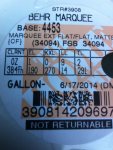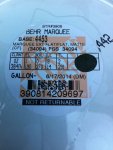Swiss could you please explain your last post. What don't you like about the behr paint? What urethane did you use? In a few more weeks I will be painting and I have yet to buy paint so would I like to see as much info as possible. Thanks for your input!
The Behr paint is a softer surface, it is not urethane which is almost like a rock hard surface. That said it looks okay but the urethane looks great.
Okay some background. The Behr paint job on the M923 was a wash of the truck with good CARC underneath with a very very heavy degreaser. This allowed for a good surface for adhesion and a limited amount of preparation work. It was a quicker paint job in terms of the overall time and effort.
The M1009 Urethane paint job was a complete paint removal almost, sanding etc then a build up of a new surface with an Epoxy high build primer and then 3 coats of urethane on top. The urethane was TM9 Ordnance
https://www.tm9ordnance.com/. We had some issues with an old batch of paint and a long story finally got a new batch of paint and this paint is the same that Zout has been using on all of PapaBears trucks with excellent results. I believe that PB's trucks are using the Enamel versus the Urethane. Zout can confirm.
Now the key as Zout alluded to earlier is what surface are you going to be painting on? If a base CARC then the Behr paint allows a quick overcoat. If you have a ton of junk that is unknown with multiple layers of paint then you have to remove these first if you really want to ensure a good paint job. Surface prep is another story for another day.
The Behr is a good soft finish with a chalky kind of look and feel. The urethane is a much harder surface. If you look at any of the chemistry behind paints the urethane based paints are on the top of the hardness scale and water based lower on the scale.
I have not done the following test yet but this is a simple hardness test that would give us some details on paint hardness, I just need to find some pencils

The Pencil Hardness Test provides a simple method to test the scratch hardness of coatings. In this test, pencils in a range of 6B to 8H hardness-grade are used. Pencils graded using this system is used to measure the hardness and resistance of varnishes and paints. The resistance of a coating (also known as its pencil hardness) is determined as the grade of the hardest pencil that does not mark the coating when pressed firmly against it at a 45 degree angle.
Select a pencil and make a line about one inch long on the paint sample. If the pencil leaves a scratch, then take the next softer pencil and do the same thing. The number of the first pencil that you use after you have made a scratch in the coating that doesn't leave a mark is considered the "pencil hardness" of the coating. (There are some coatings that are so hard that even the 9H pencils will not scratch them. All of those coatings get a 9H pencil hardness rating to designate their hardness.)
Pencil Hardness for Common Coatings
• Catalyzed polyurethane: 9H
• Catalyzed modified acrylic polyurethane: 4H
• Catalyzed acrylic polyurethane: 2H
• Water-based polyurethane: 3H
• Water-based urethane/isocyanate catalyst: 2H
• Low-VOC lacquer: 3H
• Low-VOC catalyzed lacquer: 2H (24 hours)
• Urethane/nitrocellulose lacquer: F (24 hours)
• Clear shellac aerosol: 3B
• Polyurethane/nitrocellulose aerosol: HB



![389647_3232149171486_811122016_n[1].jpg 389647_3232149171486_811122016_n[1].jpg](https://www.steelsoldiers.com/data/attachments/340/340793-2567fc99bba3ccd2944c7ddc956fabbc.jpg)
![542936_3232157611697_1994472921_n[1].jpg 542936_3232157611697_1994472921_n[1].jpg](https://www.steelsoldiers.com/data/attachments/340/340794-7dae520203ecf64257c9994ed36a85fa.jpg)
![543756_3232149251488_143757619_n[1].jpg 543756_3232149251488_143757619_n[1].jpg](https://www.steelsoldiers.com/data/attachments/340/340798-6e80e39c6b1410e4a16cda502c548e69.jpg)
![554677_3232162291814_1197792598_n[1].jpg 554677_3232162291814_1197792598_n[1].jpg](https://www.steelsoldiers.com/data/attachments/340/340799-241d3e97ba6291d2e3b62f24cbebd33b.jpg)
![554677_3232162371816_842994243_n[1].jpg 554677_3232162371816_842994243_n[1].jpg](https://www.steelsoldiers.com/data/attachments/340/340800-52f7b83775e7d3980fc8e0dfd8b7d2d4.jpg)
![1074712_10200268679028512_1484805679_o[1].jpg 1074712_10200268679028512_1484805679_o[1].jpg](https://www.steelsoldiers.com/data/attachments/340/340801-b52a0824cf5c4b6f53136960fb6ef914.jpg)
